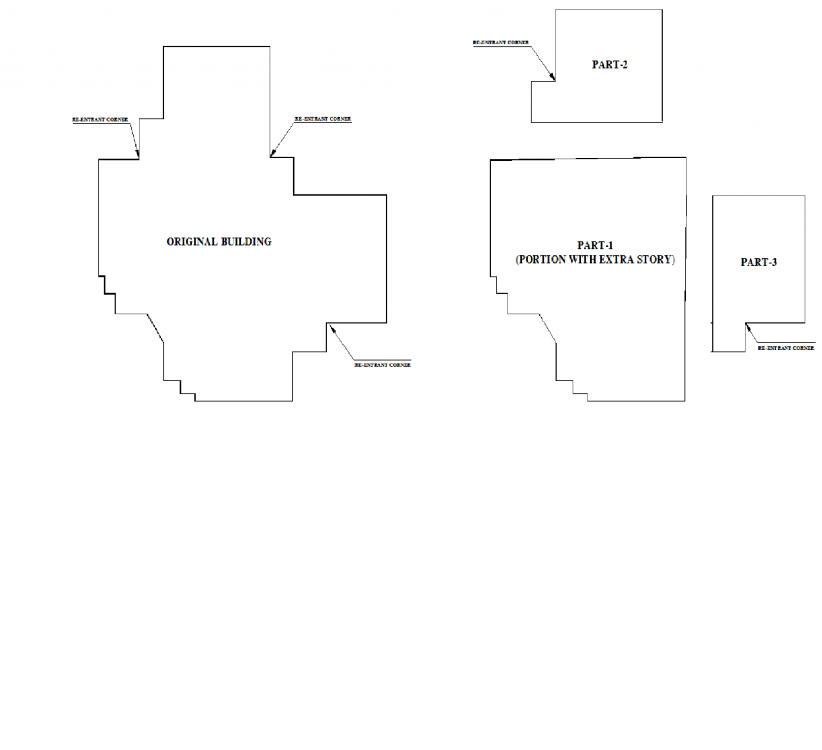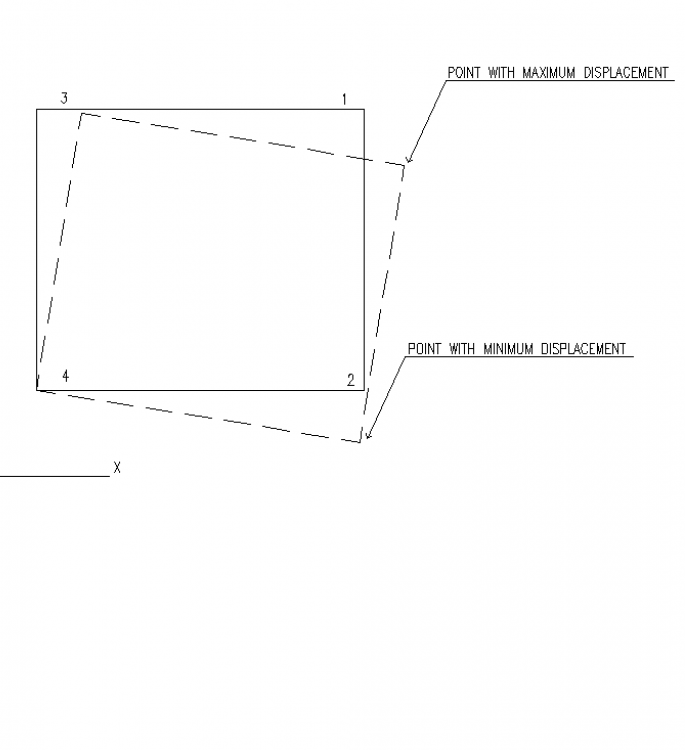Search the Community
Showing results for tags 'ubc 97'.
-
Assalam o alaikum. My building has special moment frames and 3 to 4 shear walls. The bay where shear walls are placed, no column is in the bay and beams are coming directly at top of shear wall and for the very specific bay, slab is also resting directly at shear wall at that location. How to decide in which category, exactly, my structure comes? UBC structural systems are 1629.6 Structural Systems. 1629.6.1 General. Structural systems shall be classified as one of the types listed in Table 16-N and defined in this section. 1629.6.2 Bearing wall system. A structural system without a complete vertical load-carrying space frame. Bearing walls or bracing systems provide support for all or most gravity loads. Resistance to lateral load is provided by shear walls or braced frames. I think my structure does not lie in this category because majority of slab and walls are resting at beams connected with columns. Am i right? 1629.6.3 Building frame system. A structural system with an essentially complete space frame providing support for gravity loads. Resistance to lateral load is provided by shear walls or braced frames. Is this structure is where no lateral load is resisted by frame and shear walls resist lateral loads? How is it possible that no lateral load is resisted by frames? 1629.6.4 Moment-resisting frame system. A structural system with an essentially complete space frame providing support for gravity loads. Moment-resisting frames provide resistance to lateral load primarily by flexural action of members. If I have 7 bays in a direction at a grid and I have 5 to 6 grids in building. An only end grids have shear walls in one or two bays, Will it be considered as building MRF or Dual system? What is exact differentiation between them? 1629.6.5 Dual system. A structural system with the following features: 1. An essentially complete space frame that provides support for gravity loads. 2. Resistance to lateral load is provided by shear walls or braced frames and moment-resisting frames (SMRF, IMRF, MMRWF or steel OMRF). The moment-resisting frames shall be designed to independently resist at least 25 percent of the design base shear. 3. The two systems shall be designed to resist the total design base shear in proportion to their relative rigidities considering the interaction of the dual system at all levels. Is there any limit that at least this much of base shear must be resisted by shear wall to consider it as Dual system otherwise it is MRF? Thanks.
- 11 replies
-
- structural systems
- ubc 97
-
(and 1 more)
Tagged with:
-
ETAB's V2018 removed the UBC 97 the old n obsolete code. http://installs.csiamerica.com/software/ETABS/18/ReleaseNotesETABSv1801.pdf Incident#234426 Description. 3 What is the way forward for generating seismic forces as per UBC-97 in the future via software. What could be alternative ways which are code compliant or acceptable in light of Building code of Pakistan-2007 seismic provision??
-
AOA, Kindly email me UBC 97 (All volumes) & ASCE 7-O5. Tufail_mabood@yahoo.com JazakAllah Khair.
-
Assalam o alaikum. I am attaching image of plan of a building. It is having wing projections more than 15% as shown in attached image. And also Vertical irregularity i.e. Only center part of building has 3rd story and rest of parts dont have. I have the following questions. 1) To consider building a re-entrant corner or of irregularity type-2 according to UBS-Table 16-M, is it necessary for a building to have both side projects of a corner greater than 15% of dimension or even one side projection is greater than 15% still it will be considered as re-entrant corner? Table says for Re-entrant corners, refer 1633.2.9 item 6 and 7 which says, item 6 : "Connections of diaphragms to the vertical elements in structures in Seismic Zones 3 and 4, having a plan irregularity of Type 1, 2, 3 or 4 in Table 16-M, shall be designed without considering either the one-third increase or the duration of load increase considered in allowable stresses for elements resisting earthquake forces." Q: WHAT ABOUT STRENGTH DESIGN METHOD? WHAT IS ALTERNATE WAY OF CAPTURING THIS POINT IN STRENGTH DESIGN METHOD? item 7: "In structures in Seismic Zones 3 and 4 having a plan irregularity of Type 2 in Table 16-M, diaphragm chords and drag members shall be designed considering independent movement of the projecting wings of the structure. Q: WHAT IS A DIAPHRAGM CHORD AND DRAG MEMBER? WHAT THEY REPRESENT STRUCTURALLY IN A CONCRETE BUILDING? Each of these diaphragm elements shall be designed for the more severe of the following two assumptions: Motion of the projecting wings in the same direction. Motion of the projecting wings in opposing directions. Q : KINDLY EXPLAIN ITS WORDING? EXCEPTION: This requirement may be deemed satisfied if the procedures of Section 1631 in conjunction with a three-dimensional model have been used to determine the lateral seismic forces for design. 2) If i divide the building into 3 parts, still it have in Part 2 and 3 re-entrant corners. Should I consider It or as it seems not exceeding much than 15% in one direction, I can ignore it. It is basically a stair case. 3) The part 1 of building has an extra story i.e. total 3 stories but wings have only 2 stories. As it can be seen roughly from plan, The lower story is more than 130% of the upper story so It is, in my opinion, vertical geometric irregularity. Should I worry for this vertical geometry? Should I go for Dynamic anlysis as suggested by reference section for the same table to consider section 1629.8.4 item 2 which says "2. dynamic analysis shall be done for structures having a stiffness, weight or geometric vertical irregularity of Type 1, 2 or 3, as defined in Table 16-L, or structures having irregular features not described in Table 16-L or 16-M, except as permitted by Section 1630.4.2. " BUT AT THE SAME TIME section 1629.8.3 item 3 says " Static analysis is permitted for Irregular structures not more than five stories or 65 feet (19 812 mm) in height." and 1629.8.4 item 3 says "3. Dynamic analysis shall be done Structures over five stories or 65 feet (19 812 mm) in height in Seismic Zones 3 and 4 not having the same structural system throughout their height except as permitted by Section 1630.4.2." Hence Item 3 of both 1629.8.3 and 1629.8.4 says only if irregular structures are less than 5 story, static analysis is permitted but 1629.8.4 item 2 says for vertical irregularity dynamic analysis shall be done. Kindly explain. PS: I m planing to divide the building into 3 parts and shown to avoid any of the irregularity. But if in certain case, i can not divide it, how to interpret the UBC conditions. Thanks.
- 6 replies
-
- re entrant corner
- vertical irregularity
-
(and 2 more)
Tagged with:
-
Assalam o alaikum. I have gone through previous posts regarding this topic but still i m unable to get the exact way to check torsional irregularity. What I have concluded through surfing and conversation regarding this topic with some of forum members, I m posting it with uncertainty that I have get it right or not. Kindly place your valuable comment. I m attaching a simple plan with the deformed floor shape under EQx loading with minimum eccentricity. I have labeled points. If X axis towards right, as marked in picture, For EQx loading with (say) 5% eccentricity, the following shape is gotten. Now UBC97 says, the building will be irregular if "Maximum story drift, computed including accidental torsion, at one end of the structure transverse to an axis is more than 1.2 times the average of the story drifts of the two ends of the structure ." My confusion lies specially in the bold part. Transverse to an axis (What axis) and two end of the structure (when two ends of structure)? Besides the confusion under wording, what i have been guided by other fellows is that, we need to check for EQx, the displacement of Point 1 under EQx drift combos (This will be the maximum displacement) and the displacement of Point 2 under EQx drift combos (This will be the minimum displacement). Then we need to compare the maximum displacement that is of point 1, to the average of this maximum and minimum displacements of point 1 and 2 respectively If this ratio is greater than 1.2, there will be torsional irregularity and if it is greater than 1.4, there will be extreme torsional irregularity. And we need to provide stiff columns or shear walls accordingly to reduce this ratio under 1.2 to eliminate torsional irregularity. Am i getting it right? Thanks.
- 2 replies
-
- torsional irregularity
- table 16-m
-
(and 2 more)
Tagged with:
.thumb.jpg.700916fbc7ead330085e15745d0270bd.jpg)


